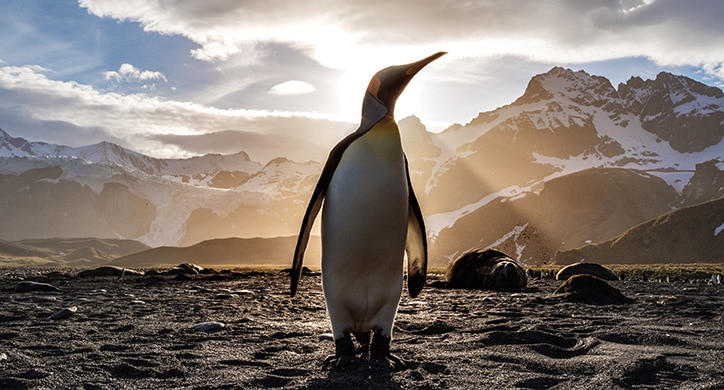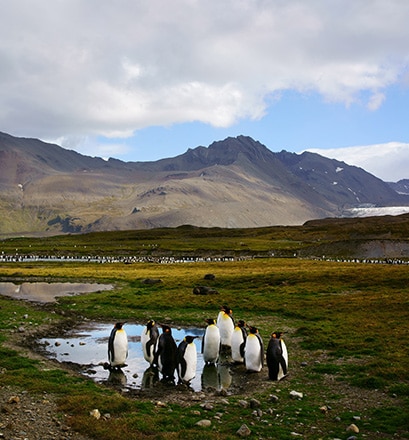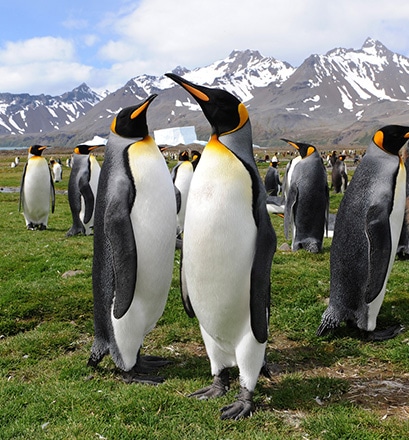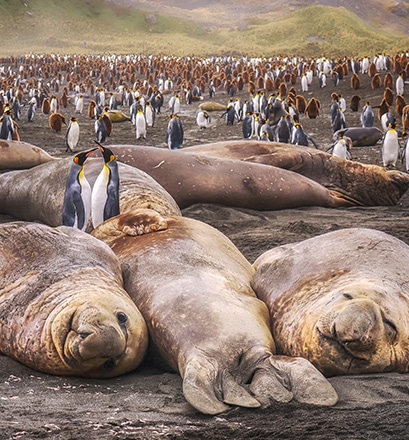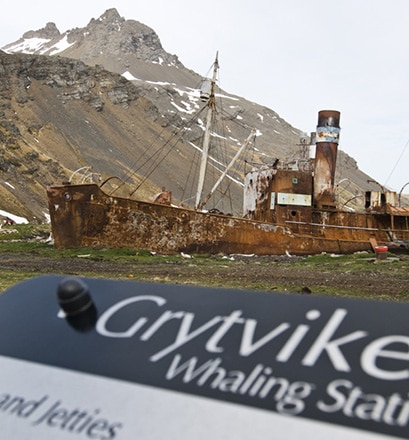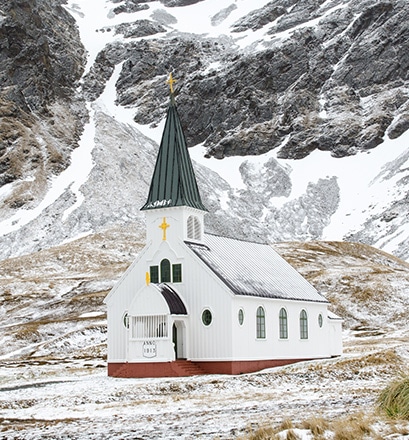The store will not work correctly in the case when cookies are disabled.
JavaScript seems to be disabled in your browser.
For the best experience on our site, be sure to turn on Javascript in your browser.
Or
Which period?
Select the period
June 2025
July 2025
August 2025
September 2025
October 2025
November 2025
December 2025
January 2026
February 2026
March 2026
April 2026
May 2026
June 2026
July 2026
August 2026
September 2026
October 2026
November 2026
December 2026
January 2027
February 2027
March 2027
April 2027
May 2027
June 2027
July 2027
August 2027
September 2027
October 2027
November 2027
December 2027
Close
Explore our list of 17 cruises
Situated between Ushuaia and the Antarctic Peninsula, South Georgia is a fascinating stop on the way to the White Continent . Snowy peaks and impressive glaciers serve as magnificent backdrops for an exceptional fauna. Penguins, elephant seals, and whales inhabit the waters and shores of these lands, which have in the past served as whaling stations and bases for the daring explorers of the 20 th century.
All about cruises South Georgia
Our other destinations
BO201226;LY111125;AU131225;LY250126;BO160226;BO150227
Ushuaia - Ushuaia
NIGHT IN BUENOS AIRES + FLIGHT BUENOS AIRES/USHUAIA + VISIT+ FLIGHT USHUAIA/BUENOS AIRES
16/11/2026 to 04/12/2026
Ushuaia
Ushuaia
LE LYRIAL
UUIZ45 - LY171126
20% Ponant Bonus
17,135 €
Superior Stateroom
17,135.00 €
Book
Deluxe Stateroom Deck 3
18,315.00 €
Fully booked
Prestige Stateroom Deck 4
19,145.00 €
Book
Prestige Stateroom Deck 5
19,475.00 €
Book
Prestige Stateroom Deck 6
19,975.00 €
Fully booked
Deluxe Suite Deck 6
28,335.00 €
Book
Prestige Suite Deck 5
29,505.00 €
Book
Privilège Suite Deck 6
32,005.00 €
Book
Grand Deluxe Suite Deck 6
39,035.00 €
Book
Grand Privilege Suite
40,195.00 €
Fully booked
Owner's Suite Deck 6
50,935.00 €
Book
03/12/2026 to 21/12/2026
Ushuaia
Ushuaia
LE LYRIAL
UUIY45 - LY041226
20% Ponant Bonus
17,135 €
Superior Stateroom
17,135.00 €
Book
Deluxe Stateroom Deck 3
18,315.00 €
Book
Prestige Stateroom Deck 4
19,145.00 €
Book
Prestige Stateroom Deck 5
19,475.00 €
Book
Prestige Stateroom Deck 6
19,975.00 €
Book
Deluxe Suite Deck 6
28,335.00 €
Fully booked
Prestige Suite Deck 5
29,505.00 €
Book
Privilège Suite Deck 6
32,005.00 €
Book
Grand Deluxe Suite Deck 6
39,035.00 €
Fully booked
Grand Privilege Suite
40,195.00 €
Book
Owner's Suite Deck 6
50,935.00 €
Book
14/02/2027 to 04/03/2027
Ushuaia
Ushuaia
LE BORÉAL
UUJH45 - BO150227
5% Ponant Bonus
19,765 €
Superior Stateroom Deck 3
19,765.00 €
Book
Deluxe Stateroom Deck 3
21,165.00 €
Fully booked
Prestige Stateroom Deck 4
22,145.00 €
Book
Prestige Stateroom Deck 5
22,545.00 €
Book
Prestige Stateroom Deck 6
23,135.00 €
Book
Deluxe Suite Deck 6
33,065.00 €
Book
Prestige Suite Deck 5
34,455.00 €
Book
Prestige Suite Deck 6
36,235.00 €
Book
Owner's Suite Deck 6
48,015.00 €
Book
Ushuaia - Ushuaia
Night in Buenos Aires + flight Buenos Aires/Ushuaia + visit + flight Ushuaia/Buenos Aires
12/12/2025 to 30/12/2025
Ushuaia
Ushuaia
L'AUSTRAL
UUHO45 - AU131225
20,255 €
Superior Stateroom Deck 3
20,255.00 €
Fully booked
Deluxe Stateroom Deck 3
21,685.00 €
Book
Prestige Stateroom Deck 4
22,705.00 €
Book
Prestige Stateroom Deck 5
23,115.00 €
Book
Prestige Stateroom Deck 6
23,735.00 €
Book
Deluxe Suite Deck 6
33,975.00 €
Fully booked
Prestige Suite Deck 5
35,405.00 €
Fully booked
Prestige Suite Deck 6
37,255.00 €
Fully booked
Owner's Suite Deck 6
47,085.00 €
Book
20/12/2025 to 07/01/2026
Ushuaia
Ushuaia
LE BORÉAL
UUIC45 - BO211225
10% Ponant Bonus
20,845 €
Superior Stateroom Deck 3
20,845.00 €
Fully booked
Deluxe Stateroom Deck 3
22,325.00 €
Fully booked
Prestige Stateroom Deck 4
23,375.00 €
Book
Prestige Stateroom Deck 5
23,795.00 €
Book
Prestige Stateroom Deck 6
24,425.00 €
Book
Deluxe Suite Deck 6
34,955.00 €
Book
Prestige Suite Deck 5
36,435.00 €
Book
Prestige Suite Deck 6
38,335.00 €
Book
Owner's Suite Deck 6
53,495.00 €
Book
24/01/2026 to 11/02/2026
Ushuaia
Ushuaia
LE LYRIAL
UUHY45 - LY250126
22,655 €
Superior Stateroom
22,655.00 €
Book
Deluxe Stateroom Deck 3
24,275.00 €
Book
Prestige Stateroom Deck 4
25,435.00 €
Fully booked
Prestige Stateroom Deck 5
25,905.00 €
Book
Prestige Stateroom Deck 6
26,595.00 €
Fully booked
Deluxe Suite Deck 6
38,205.00 €
Book
Prestige Suite Deck 5
39,835.00 €
Fully booked
Privilège Suite Deck 6
43,315.00 €
Book
Grand Deluxe Suite Deck 6
53,065.00 €
Fully booked
Grand Privilege Suite
54,685.00 €
Fully booked
Owner's Suite Deck 6
56,315.00 €
Fully booked
15/02/2026 to 05/03/2026
Ushuaia
Ushuaia
LE BORÉAL
UUIH45 - BO160226
5% Ponant Bonus
19,395 €
Superior Stateroom Deck 3
19,395.00 €
Fully booked
Deluxe Stateroom Deck 3
20,745.00 €
Book
Prestige Stateroom Deck 4
21,715.00 €
Book
Prestige Stateroom Deck 5
22,105.00 €
Book
Prestige Stateroom Deck 6
22,695.00 €
Book
Deluxe Suite Deck 6
32,425.00 €
Book
Prestige Suite Deck 5
33,785.00 €
Fully booked
Prestige Suite Deck 6
35,545.00 €
Book
Owner's Suite Deck 6
47,085.00 €
Book
Ushuaia - Ushuaia
Night in Buenos Aires + flight Buenos Aires/Ushuaia + visit + flight Ushuaia/Buenos Aires
10/11/2025 to 28/11/2025
Ushuaia
Ushuaia
LE LYRIAL
UUIL45 - LY111125
20,255 €
Superior Stateroom
20,255.00 €
Fully booked
Deluxe Stateroom Deck 3
21,685.00 €
Fully booked
Prestige Stateroom Deck 4
22,705.00 €
Fully booked
Prestige Stateroom Deck 5
23,115.00 €
Fully booked
Prestige Stateroom Deck 6
23,735.00 €
Fully booked
Deluxe Suite Deck 6
33,975.00 €
Book
Prestige Suite Deck 5
35,405.00 €
Fully booked
Privilège Suite Deck 6
38,485.00 €
Book
Grand Deluxe Suite Deck 6
47,085.00 €
Fully booked
Grand Privilege Suite
48,515.00 €
Fully booked
Owner's Suite Deck 6
49,955.00 €
Fully booked
20/12/2025 to 07/01/2026
Ushuaia
Ushuaia
LE BORÉAL
UUIC45 - BO211225
10% Ponant Bonus
20,845 €
Superior Stateroom Deck 3
20,845.00 €
Fully booked
Deluxe Stateroom Deck 3
22,325.00 €
Fully booked
Prestige Stateroom Deck 4
23,375.00 €
Book
Prestige Stateroom Deck 5
23,795.00 €
Book
Prestige Stateroom Deck 6
24,425.00 €
Book
Deluxe Suite Deck 6
34,955.00 €
Book
Prestige Suite Deck 5
36,435.00 €
Book
Prestige Suite Deck 6
38,335.00 €
Book
Owner's Suite Deck 6
53,495.00 €
Book
24/01/2026 to 11/02/2026
Ushuaia
Ushuaia
LE LYRIAL
UUHY45 - LY250126
22,655 €
Superior Stateroom
22,655.00 €
Book
Deluxe Stateroom Deck 3
24,275.00 €
Book
Prestige Stateroom Deck 4
25,435.00 €
Fully booked
Prestige Stateroom Deck 5
25,905.00 €
Book
Prestige Stateroom Deck 6
26,595.00 €
Fully booked
Deluxe Suite Deck 6
38,205.00 €
Book
Prestige Suite Deck 5
39,835.00 €
Fully booked
Privilège Suite Deck 6
43,315.00 €
Book
Grand Deluxe Suite Deck 6
53,065.00 €
Fully booked
Grand Privilege Suite
54,685.00 €
Fully booked
Owner's Suite Deck 6
56,315.00 €
Fully booked
15/02/2026 to 05/03/2026
Ushuaia
Ushuaia
LE BORÉAL
UUIH45 - BO160226
5% Ponant Bonus
19,395 €
Superior Stateroom Deck 3
19,395.00 €
Fully booked
Deluxe Stateroom Deck 3
20,745.00 €
Book
Prestige Stateroom Deck 4
21,715.00 €
Book
Prestige Stateroom Deck 5
22,105.00 €
Book
Prestige Stateroom Deck 6
22,695.00 €
Book
Deluxe Suite Deck 6
32,425.00 €
Book
Prestige Suite Deck 5
33,785.00 €
Fully booked
Prestige Suite Deck 6
35,545.00 €
Book
Owner's Suite Deck 6
47,085.00 €
Book
Ushuaia - Ushuaia
Night in Buenos Aires + flight Buenos Aires/Ushuaia + visit + flight Ushuaia/Buenos Aires
10/11/2025 to 28/11/2025
Ushuaia
Ushuaia
LE LYRIAL
UUIL45 - LY111125
20,255 €
Superior Stateroom
20,255.00 €
Fully booked
Deluxe Stateroom Deck 3
21,685.00 €
Fully booked
Prestige Stateroom Deck 4
22,705.00 €
Fully booked
Prestige Stateroom Deck 5
23,115.00 €
Fully booked
Prestige Stateroom Deck 6
23,735.00 €
Fully booked
Deluxe Suite Deck 6
33,975.00 €
Book
Prestige Suite Deck 5
35,405.00 €
Fully booked
Privilège Suite Deck 6
38,485.00 €
Book
Grand Deluxe Suite Deck 6
47,085.00 €
Fully booked
Grand Privilege Suite
48,515.00 €
Fully booked
Owner's Suite Deck 6
49,955.00 €
Fully booked
12/12/2025 to 30/12/2025
Ushuaia
Ushuaia
L'AUSTRAL
UUHO45 - AU131225
20,255 €
Superior Stateroom Deck 3
20,255.00 €
Fully booked
Deluxe Stateroom Deck 3
21,685.00 €
Book
Prestige Stateroom Deck 4
22,705.00 €
Book
Prestige Stateroom Deck 5
23,115.00 €
Book
Prestige Stateroom Deck 6
23,735.00 €
Book
Deluxe Suite Deck 6
33,975.00 €
Fully booked
Prestige Suite Deck 5
35,405.00 €
Fully booked
Prestige Suite Deck 6
37,255.00 €
Fully booked
Owner's Suite Deck 6
47,085.00 €
Book
20/12/2025 to 07/01/2026
Ushuaia
Ushuaia
LE BORÉAL
UUIC45 - BO211225
10% Ponant Bonus
20,845 €
Superior Stateroom Deck 3
20,845.00 €
Fully booked
Deluxe Stateroom Deck 3
22,325.00 €
Fully booked
Prestige Stateroom Deck 4
23,375.00 €
Book
Prestige Stateroom Deck 5
23,795.00 €
Book
Prestige Stateroom Deck 6
24,425.00 €
Book
Deluxe Suite Deck 6
34,955.00 €
Book
Prestige Suite Deck 5
36,435.00 €
Book
Prestige Suite Deck 6
38,335.00 €
Book
Owner's Suite Deck 6
53,495.00 €
Book
15/02/2026 to 05/03/2026
Ushuaia
Ushuaia
LE BORÉAL
UUIH45 - BO160226
5% Ponant Bonus
19,395 €
Superior Stateroom Deck 3
19,395.00 €
Fully booked
Deluxe Stateroom Deck 3
20,745.00 €
Book
Prestige Stateroom Deck 4
21,715.00 €
Book
Prestige Stateroom Deck 5
22,105.00 €
Book
Prestige Stateroom Deck 6
22,695.00 €
Book
Deluxe Suite Deck 6
32,425.00 €
Book
Prestige Suite Deck 5
33,785.00 €
Fully booked
Prestige Suite Deck 6
35,545.00 €
Book
Owner's Suite Deck 6
47,085.00 €
Book
Ushuaia - Ushuaia
Night in Buenos Aires + flight Buenos Aires/Ushuaia + visit + flight Ushuaia/Buenos Aires
10/11/2025 to 28/11/2025
Ushuaia
Ushuaia
LE LYRIAL
UUIL45 - LY111125
20,255 €
Superior Stateroom
20,255.00 €
Fully booked
Deluxe Stateroom Deck 3
21,685.00 €
Fully booked
Prestige Stateroom Deck 4
22,705.00 €
Fully booked
Prestige Stateroom Deck 5
23,115.00 €
Fully booked
Prestige Stateroom Deck 6
23,735.00 €
Fully booked
Deluxe Suite Deck 6
33,975.00 €
Book
Prestige Suite Deck 5
35,405.00 €
Fully booked
Privilège Suite Deck 6
38,485.00 €
Book
Grand Deluxe Suite Deck 6
47,085.00 €
Fully booked
Grand Privilege Suite
48,515.00 €
Fully booked
Owner's Suite Deck 6
49,955.00 €
Fully booked
12/12/2025 to 30/12/2025
Ushuaia
Ushuaia
L'AUSTRAL
UUHO45 - AU131225
20,255 €
Superior Stateroom Deck 3
20,255.00 €
Fully booked
Deluxe Stateroom Deck 3
21,685.00 €
Book
Prestige Stateroom Deck 4
22,705.00 €
Book
Prestige Stateroom Deck 5
23,115.00 €
Book
Prestige Stateroom Deck 6
23,735.00 €
Book
Deluxe Suite Deck 6
33,975.00 €
Fully booked
Prestige Suite Deck 5
35,405.00 €
Fully booked
Prestige Suite Deck 6
37,255.00 €
Fully booked
Owner's Suite Deck 6
47,085.00 €
Book
20/12/2025 to 07/01/2026
Ushuaia
Ushuaia
LE BORÉAL
UUIC45 - BO211225
10% Ponant Bonus
20,845 €
Superior Stateroom Deck 3
20,845.00 €
Fully booked
Deluxe Stateroom Deck 3
22,325.00 €
Fully booked
Prestige Stateroom Deck 4
23,375.00 €
Book
Prestige Stateroom Deck 5
23,795.00 €
Book
Prestige Stateroom Deck 6
24,425.00 €
Book
Deluxe Suite Deck 6
34,955.00 €
Book
Prestige Suite Deck 5
36,435.00 €
Book
Prestige Suite Deck 6
38,335.00 €
Book
Owner's Suite Deck 6
53,495.00 €
Book
24/01/2026 to 11/02/2026
Ushuaia
Ushuaia
LE LYRIAL
UUHY45 - LY250126
22,655 €
Superior Stateroom
22,655.00 €
Book
Deluxe Stateroom Deck 3
24,275.00 €
Book
Prestige Stateroom Deck 4
25,435.00 €
Fully booked
Prestige Stateroom Deck 5
25,905.00 €
Book
Prestige Stateroom Deck 6
26,595.00 €
Fully booked
Deluxe Suite Deck 6
38,205.00 €
Book
Prestige Suite Deck 5
39,835.00 €
Fully booked
Privilège Suite Deck 6
43,315.00 €
Book
Grand Deluxe Suite Deck 6
53,065.00 €
Fully booked
Grand Privilege Suite
54,685.00 €
Fully booked
Owner's Suite Deck 6
56,315.00 €
Fully booked
Ushuaia - Ushuaia
NIGHT IN BUENOS AIRES + FLIGHT BUENOS AIRES/USHUAIA + VISIT+ FLIGHT USHUAIA/BUENOS AIRES
16/11/2026 to 04/12/2026
Ushuaia
Ushuaia
LE LYRIAL
UUIZ45 - LY171126
20% Ponant Bonus
17,135 €
Superior Stateroom
17,135.00 €
Book
Deluxe Stateroom Deck 3
18,315.00 €
Fully booked
Prestige Stateroom Deck 4
19,145.00 €
Book
Prestige Stateroom Deck 5
19,475.00 €
Book
Prestige Stateroom Deck 6
19,975.00 €
Fully booked
Deluxe Suite Deck 6
28,335.00 €
Book
Prestige Suite Deck 5
29,505.00 €
Book
Privilège Suite Deck 6
32,005.00 €
Book
Grand Deluxe Suite Deck 6
39,035.00 €
Book
Grand Privilege Suite
40,195.00 €
Fully booked
Owner's Suite Deck 6
50,935.00 €
Book
03/12/2026 to 21/12/2026
Ushuaia
Ushuaia
LE LYRIAL
UUIY45 - LY041226
20% Ponant Bonus
17,135 €
Superior Stateroom
17,135.00 €
Book
Deluxe Stateroom Deck 3
18,315.00 €
Book
Prestige Stateroom Deck 4
19,145.00 €
Book
Prestige Stateroom Deck 5
19,475.00 €
Book
Prestige Stateroom Deck 6
19,975.00 €
Book
Deluxe Suite Deck 6
28,335.00 €
Fully booked
Prestige Suite Deck 5
29,505.00 €
Book
Privilège Suite Deck 6
32,005.00 €
Book
Grand Deluxe Suite Deck 6
39,035.00 €
Fully booked
Grand Privilege Suite
40,195.00 €
Book
Owner's Suite Deck 6
50,935.00 €
Book
19/12/2026 to 06/01/2027
Ushuaia
Ushuaia
LE BORÉAL
UUJG45 - BO201226
20% Ponant Bonus
19,235 €
Superior Stateroom Deck 3
19,235.00 €
Fully booked
Deluxe Stateroom Deck 3
20,575.00 €
Book
Prestige Stateroom Deck 4
21,535.00 €
Book
Prestige Stateroom Deck 5
21,915.00 €
Book
Prestige Stateroom Deck 6
22,485.00 €
Book
Deluxe Suite Deck 6
32,035.00 €
Fully booked
Prestige Suite Deck 5
33,375.00 €
Book
Prestige Suite Deck 6
35,095.00 €
Book
Owner's Suite Deck 6
54,555.00 €
Fully booked
Price is per person, based on double occupancy, based on availability, and subject to change at any time. The category of stateroom to which this price applies may no longer be available.
Highlights - South Georgia
South Georgia is one of the few submerged lands in the Southern Ocean and one of the key ports of call for Antarctic cruises. This snow-covered crescent on the surface of the water reveals its history through the remnants of whaling stations, shows off its beauty through breathtaking landscapes, and entices admiration with its exceptional fauna . Find out more about our five must-see attractions in South Georgia.
Read more
Highlights - South Georgia
South Georgia is one of the few submerged lands in the Southern Ocean and one of the key ports of call for Antarctic cruises. This snow-covered crescent on the surface of the water reveals its history through the remnants of whaling stations, shows off its beauty through breathtaking landscapes, and entices admiration with its exceptional fauna . Find out more about our five must-see attractions in South Georgia.
Find yourself in unimaginable surroundings
Berth in South Georgia and discover incredible panoramas. The grey sandy beaches follow on from plains of tussock (high grass) that roll down from the peaks. South Georgia is a region formed by an underwater mountain range that extends from the Andes to the Antarctic Peninsula. The result? Eleven peaks rise to more than 2,000 metres, the highest of which, Mount Paget, hits 2,330 metres. The island is emblematic of the Southern Ocean, because it gives a first taste of the Antarctic landscapes. Glaciers and eternal snow cover more than half of this island, located more than 1,700 kilometres from Tierra del Fuego.
Get up close to a colony of king penguins
Visit a whole new world in which thousands of king penguins come and go in their well-organised society, indifferent to any human presence. If you're lucky enough to visit Salisbury Plain or Saint Andrews, you'll witness an incredible show: Salisbury Plain is home to no fewer than 250,000 penguins, and in Saint Andrews, 100,000 couples of chinstrap penguins, gentoos, macaronis , and many others frolic together.
Fall in love with the marine wildlife
In the 1900s, only about 100 Antarctic fur seals remained due to intensive hunting. Today, there are about 2.5 million, 95% of which live in South Georgia. Each year, 600,000 elephant seals also breed on the island.Killer whales, humpback whales , and other cetaceans often accompany ships on their journeys to Antarctica.
Uncover the history of the first whaling stations
While marine mammals now swim in the icy waters in complete tranquillity, this hasn't always been the case. In 1904, the Norwegians set up the first whaling stations in South Georgia, and the last one remained in operation until 1965. The bones of these sea giants are still visible today on some shores. It is now estimated that more than 1.7 million whales were killed in South Georgia during this period.
Walk in the footsteps of the great explorers
South Georgia is also the resting place of Sir Ernest Shackleton 's remains. The British explorer went down in history for having kept his men alive for 22 months in Antarctica after the loss of his ice-crushed ship during the Endurance expedition. A cruise to Antarctica means following in the footsteps of the adventurers who contributed to our understanding of the South Pole, from James Cook to Roald Amundsen , including Jean-Baptiste Charcot , Adrien de Gerlache , and Paul-Émile Victor .
More destinations in Antarctica
Discover our cruises in South Georgia going through
Ponant brochures
Want to find out more about our unique and exceptional destinations?
What will your next trip look like
South Georgia ?
Destinations
Click on the items you want to select.
You can select multiple. You can click on an item again to deselect it.
Month
Click on the items you want to select.
You can select multiple. You can click on an item again to deselect it.
Ship
Click on the items you want to select.
You can select multiple. You can click on an item again to deselect it.
Theme
Click on the items you want to select.
You can select multiple. You can click on an item again to deselect it.
Offer
Click on the items you want to select.
You can select multiple. You can click on an item again to deselect it.
Discover other destinations
